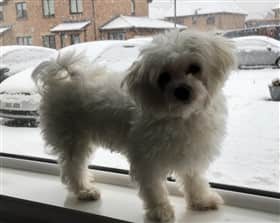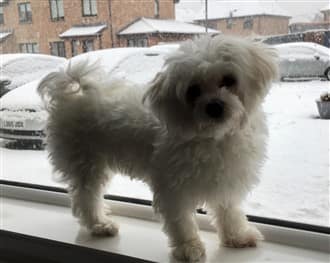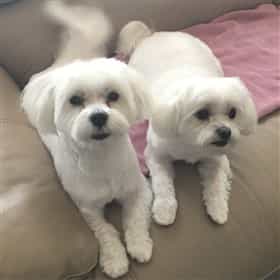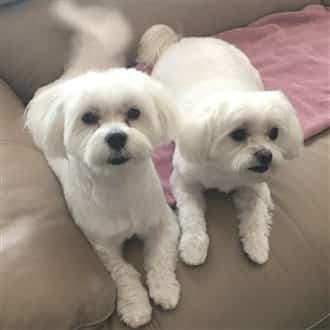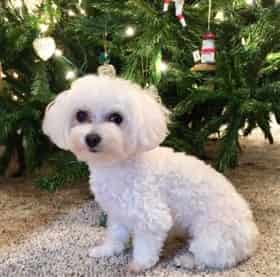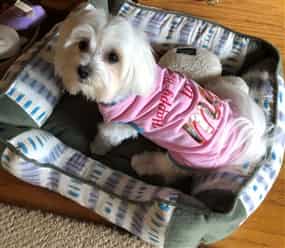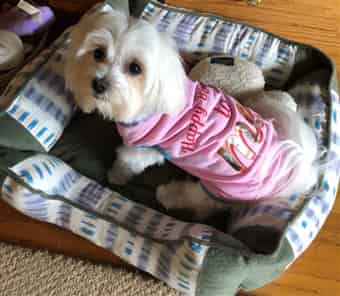Maltese Winter Care
Overview
If you live somewhere that experiences cold winters, there will be some changes that you'll need to incorporate into your Maltese's care. Ideally, prepping for this will start in late autumn, but these elements will help at any time.
This article will cover the details of these 7 top tips for taking care of your Maltese in the winter:
- Keep skin and coat in good shape.
- Keep humidity levels at 40%.
- Winterize the paws.
- Winterize the nose.
- Keep your Maltese active while staying warm.
- Have a plan for bathroom needs during bad weather.
- Reassess indoor comfort.
The goal is to keep your puppy or dog happy, warm, safe, and healthy no matter how much it snows or how low the temperature drops.
Please note:
PetMaltese is reader-supported. Some of the product suggestions on this page are affiliate links. As an Amazon Associate we earn from qualifying purchases. This is at no extra cost to you and helps us continue creating useful content.
Chanel, photo courtesy of Bobbie Schmitt
Winter Tip #1: Keep Skin & Coat in Good Shape
What happens:
For breeds like the Maltese that have silky hair, it's not uncommon to suffer from the effects of dry winter air. Cold air in the winter holds a lot less moisture than warmer air in the spring and summer. This can cause skin and hair to become overly dry.
When the skin becomes dry, it can be quite bothersome to a dog with discomfort and lots of itching and if not treated this can worsen over time. When the coat becomes dry, the texture changes, it loses its shine, and hair shafts can become brittle often leading to breakage or split-ends. So, it is best to help prevent this since treating this can be an uphill battle as winter drones on.
What to do:
Proactively use products to prevent dry skin and hair. Of top importance will be shampoo and a coat spray. Let's look at both of these to see what they can do.
Shampoo
- Even in the winter when your Maltese may not get as dirty as other times of the year, keep giving baths every 3 weeks. This will ensure that accumulated body oils are washed off and is your opportunity to slather your Maltese with products that add moisture to skin and hairs, fix any current dry skin issues, and help prevent new ones.
There are things you'll want to avoid that can exacerbate these cold weather issues. This includes a low pH level, parabens, sulfates, soaping agents, chemical preservatives (including but not limited to methylisothiazolinone and methylchloroisothiazolinon) and dyes or heavy artificial perfumes. Unfortunately, these are found in many pet shampoos.
And, there are some things that you will want. The pH level should be between 6.5 and 7.5, cleanser should be plant-based, there should be no artificial additives, and the product should contain oatmeal, aloe, tea tree oil, or other organic ingredients that promote good skin and coat health.
While it is recommended year-round, an excellent shampoo for the winter is Earthbath Oatmeal & Aloe Shampoo with Vanilla & Almond , along with its accompanying wash-out conditioner.
, along with its accompanying wash-out conditioner.
Coat spray
- Every Maltese can benefit from a leave-in coat spray, especially in the winter. A good one will offer a layer of protection from irritants and contact friction, help control static, lock in moisture, and add shine. As a bonus, these can also keep a dog smelling nice and clean.
This should be used each time you brush your Maltese and if this is something you don't do daily, you can still mist the coat each day. When brushing, for those with medium length to long coats, spritz about 1 inch from the roots and brush down to the tips with a pin brush; you may then wish to spritz some into your hands and scrunch the hair tips. For those with very short coats, you can spray the coat and work it in with your hands or distribute it through the hairs with a bristle brush.
A great coat spray to try is The Stuff Coat Conditioner ; this works great to protect hairs and has a nice fresh scent.
; this works great to protect hairs and has a nice fresh scent.
And, another terrific choice is Nootie Daily Spritz Conditioning Spray . This line of spritzes does everything you'd expect but also offers some truly lovely fragrances such as coconut lime verbena, warm vanilla cookie (this is such a nice one in the wintertime), and cucumber melon.
. This line of spritzes does everything you'd expect but also offers some truly lovely fragrances such as coconut lime verbena, warm vanilla cookie (this is such a nice one in the wintertime), and cucumber melon.
Lulu, at 15 months old, photo courtesy of Janice Carlin
Winter Tip #2: Keep Humidity Levels in the House at 40%
What happens:
As mentioned in Tip #1, cold air has a lower humidity level than warm air and this holds true for the air in your house as well. Even when you turn on the heat to warm it, this does not add any moisture. An arid environment such as this can dry out a dog's skin and coat as covered earlier, but also dry out breathing passages which can cause itchy nasal passages, throat clearing or even coughing, snoring, or increased asthma attacks for dogs that suffer from this, as well as irritated eyes and static on the coat.
What to do:
In the winter, it is typical for air to be under 25% humidity. If your Maltese is feeling the effects of this, the goal should be to raise this to 40%.
There are a few things you can do that fall under the DIY category, though this may work to varying success. This includes having houseplants, leaving the door open when you shower, and placing bowls of water over heating vents.
Of course, the fastest, most reliable, and most effective method is use a humidifier. Ideally, you'll want enough of them to cover your entire living area; but if you have just one, place this in the room that your Maltese spends the most time. One like the PurSteam Ultrasonic Cool Mist Humidifier
 works for a medium to large size room, runs 17 to 20+ hours (depending on how dry the air is) and has automatic shut-off.
works for a medium to large size room, runs 17 to 20+ hours (depending on how dry the air is) and has automatic shut-off.
Winter Tip #3: Winterize Your Maltese's Paws
What happens:
While there can be issues year-round such as allergens and irritants clinging to the paws and summer-related issues like hot walking surfaces, winter brings about a whole new level of obstacles that require the paws to be protected.
Slippery surfaces can make it difficult for a dog to get good traction, snow can melt in between the toes only to quickly refreeze into ice and stretch the skin there (known as snowballing), ice-melt products can cause chemical burns, road salt can be harsh on the paws, and cold walking surfaces can be drying.
What to do:
Applying a quality paw wax can help prevent all of these winter-related issues by creating a barrier. It also works to keep paws properly moisturized and healthy if dry winter air is affecting paw pad skin.
One of the best paw products is Musher's Secret Pet Paw Protection
 which offers a layer of breathable protection, only needs to be applied once every two weeks, and absorbs rather quickly.
which offers a layer of breathable protection, only needs to be applied once every two weeks, and absorbs rather quickly.
Mia and Chico, both at 4 years old, photo courtesy of Damaris and Dan Patten
Winter Tip #4: Winterize Your Maltese's Nose
What happens:
One issue is the nose getting overly dry. The shampoo, coat spray, and of course paw wax, that we've covered will not do anything for the snout. Getting your home up to 40% humidity can help prevent this to some degree but will not resolve a current issue. The other winter element is chapping.
This happens because dogs lick their noses many times throughout the day. Then, when a dog goes outside into cold air, and particularly if it's windy, chapping can occur.
Once a nose is chapped, it will be painful, which causes a dog to lick it even more, and this can be an endless cycle that only gets worse and worse. Drying and chapping may progress to peeling and cracking which can be very painful and take quite some time to treat.
What to do:
Protect your Maltese's nose in the winter by applying a quality nose balm. For this, you'll want to use a product that is all-natural and organic that absorbs quickly and it is best if it is fragrance-free since having something with a scent applied to the nose can be quite irritating for a dog.
For this, Snout Soother Nose Balm
 is recommended. This contains a protective and soothing blend of organic shea butter, coconut oil, hempseed oil, grapeseed oil, jojoba, kukui oil, natural vitamin E, chamomile, and rosemary extract. For protection and maintenance, dab this on every 1 to 2 days. And, if your Maltese already has a dry, cracked nose or has crusting or other issues, this can be applied 2 to 3 times per day.
is recommended. This contains a protective and soothing blend of organic shea butter, coconut oil, hempseed oil, grapeseed oil, jojoba, kukui oil, natural vitamin E, chamomile, and rosemary extract. For protection and maintenance, dab this on every 1 to 2 days. And, if your Maltese already has a dry, cracked nose or has crusting or other issues, this can be applied 2 to 3 times per day.
Honeybun, at 3 years old, photo courtesy of Lisa Chapman
Winter Tip #5: Keep Your Maltese Active
What to know:
Do not assume that small breeds like the Maltese 'self-exercise' simply by moving about during the day. Regular light to moderate cardiovascular exercise
is needed.
This plays a big role in a dog's physical health; it helps to: keep the heart, lungs, and other body organs healthy, keep joints lubricated which helps fend off arthritis, maintain muscle mass and strength, regulate the metabolism, and ward off a range of diseases including diabetes and some forms of cancer.
It's also plays a role in a dog's emotional health; it allows a dog to release pent-up energy, cuts down on behaviors like excessive barking and destructive chewing, and can increase the owner/dog bond. In addition, during the winter, dogs can feel the negative effects of being cooped up in the house including feeling restless and/or bored and some dogs suffer from seasonal affective disorder which is connected to shorter days and less sunshine and can cause lethargy and depression.
But, of course, cold weather and icy or snowy precipitation can make it challenging to keep your Maltese moving.
What to do:
Have a plan to keep your Maltese active, implementing both indoor and outdoor activities depending on the temperature and weather conditions:
1.
Unless it is well below freezing and/or there is severely inclement weather such as snow or ice storms, continue to take your Maltese for at least two daily walks. These should be for at least 20 minutes and at a pace that has your puppy or dog trotting along briskly without running out of breath.
2. To make walks more tolerable, place a winter vest on your Maltese to keep their core body warm and dry. A great coat for small dogs in the winter is the Kuoser Cozy Cold Weather Vest for Dogs . This is a super cute reversible vest (solid on one side, plaid on the other) that has a poly fiber filled fleece lining, a wind and water-resistant outer layer, and an adjustable side closure for a comfortable fit. This starts at size xx-small and is available in several color designs.
. This is a super cute reversible vest (solid on one side, plaid on the other) that has a poly fiber filled fleece lining, a wind and water-resistant outer layer, and an adjustable side closure for a comfortable fit. This starts at size xx-small and is available in several color designs.
3.
In addition to walks and on days that it is not safe to bring your Maltese out, hold at least two 20-minute sessions of an indoor cardio activity. The easiest way to do this is to engage your dog in a game of fetch. There is a way to do this without destroying the house and that is by using a toy designed to be thrown and caught inside like the Chuckit! Indoor Roller Toy for Small Dogs .
.
4.
On long, snowy days that seem to drag on forever, keep your Maltese busy with some games that put a dog's mind to work.
Puzzle games are great for this (a dog noses at knobs or paws at levers to find treats) or a snuffle mat which is a mat filled with fluffed tufts of fabric, pockets, and other soft elements where you hide tiny training treats; this calls to a dog's love of foraging and is a great way to keep a dog occupied. A cute one for this is the Darkyazi Snuffle Mat Nosework Blanket .
.
Princess, at 2 months old, photo courtesy of Suzie Lam
Winter Tip #6: Have a Plan for Bathroom Needs
This applies to Maltese that are trained to use an outdoor bathroom area.
What happens:
Even fully house trained dogs
may resistant going outside for bathroom needs when it's super cold and snowy. And, while a winter vest (Tip #5, point 2) can help, if there is an active snowstorm, both you and your dog may have trouble getting outside, especially in the early morning or post-sunset evening.
What to do:
1.
Keep your dog's outdoor bathroom area shoveled. If you try to play catch-up once snow has settled down, dried, and compacted, it is a lot harder to clean out.
2.
Choose an area that is very close to your door and, if possible, at least partially sheltered.
3.
For very stormy days, default to having your Maltese use an indoor bathroom area. This does not necessarily need to put house training back a notch. If you lead your Maltese away to a new area, stay to supervise, and offer praise and reward for going potty, this aligns with most of the aspects of outdoor training for an easy transition back to that in the spring.
The most common way this is done is with pee pads. If your little guy or gal is not used to this, using an over-sized pad like the All-Absorb Extra Large Training Pads
 can make it easier.
can make it easier.
Or, if you think that this is something your Maltese will use a lot during the winter, you may wish to consider a grass mat. Grass mats are great for mimicking what a dog is normally used to outside. There are products with real grass like the DoggieLawn Disposable Dog Potty
 that are meant to be replaced about every two weeks.
that are meant to be replaced about every two weeks.
Molly, at almost 4 months old, photo courtesy of Mark and Irene
Winter Tip #7: Reassess Indoor Comfort
What happens:
Even if the interior temperature of your home feels comfortable to you, it may feel chilly to your Maltese. This is due to several reasons. First, Maltese have fine coats of hair, not warm fur; and particularly if the coat is trimmed short, this is not comparable to the warm clothes that most people wear in the winter. Also, in many homes there are 'cold zones' near windows, walls, and on the floor (due to heat rising).
What to do:
1.
Check your Maltese's normal resting area for drafts and cold spots. You'll want to wear a short-sleeve shirt and get down close to floor-level. If you detect an issue, move your Maltese's area to a warmer location, at least for the wintertime.
2.
Provide your Maltese with a warm bed. Just about every dog can benefit from a quality bed. A mattress with memory foam will provide proper body support which plays a huge role in bone and joint health (this is a must for those 6+ years, but very beneficial for dogs of all ages). And, in regard to winter care, a bed will offer a warm spot for naps and nighttime sleeping.
An exceptional bed for Maltese is the Friends Forever Dog Bed with Memory Foam . This is designed for small dogs, has a 2.5 inch memory foam base that provides great support at all pressure points and has a water-resistant and tear-resistant cover. It comes in a pretty light gray color that blends well with most decor.
. This is designed for small dogs, has a 2.5 inch memory foam base that provides great support at all pressure points and has a water-resistant and tear-resistant cover. It comes in a pretty light gray color that blends well with most decor.
3.
Place a soft sweater or shirt on your Maltese. This can be just the thing to help your Maltese feel comfortable. A super cute one is the CHBORLESS Classic Knitwear Sweater . This is a lightweight three-quarter length sleeve top, perfect for indoor wear. There are 10 colors to choose from and this starts at size extra-extra-small. Note that this runs a bit small, so you may want to opt for one size up.
. This is a lightweight three-quarter length sleeve top, perfect for indoor wear. There are 10 colors to choose from and this starts at size extra-extra-small. Note that this runs a bit small, so you may want to opt for one size up.
Missy, at 1 year old, photo courtesy of Candy
A Final Word
Winter can be a tricky season for taking proper care of a puppy or dog; but, with a bit of planning and a few changes in tactics, your Maltese can stay happy, comfortable, warm, and healthy no matter how much snow we're buried under or how brutally cold it gets. And, before you know it, it'll be springtime again!
You May Also Like:
Supplements for Maltese
- For certain issues, supplements can play a big role in resolving issues. Also, there is one type that just about every Maltese over the age of 6 should be given.
Harnesses for Maltese
- Toy breeds like the Maltese should not be walked using a collar; a harness should be used instead.
Maltese Senior Care
- A great guideline for taking care of your senior Maltese. Applies to dogs age 8 and up.
The Best Shampoos for Maltese
- Shampoos that are great for keeping the coat white and skin and hairs in great shape.
Spotlight Article
Covering the best feeding schedule, dry vs wet, the best brands for this breed, and more.

-min-450x169-1920w.jpg)


